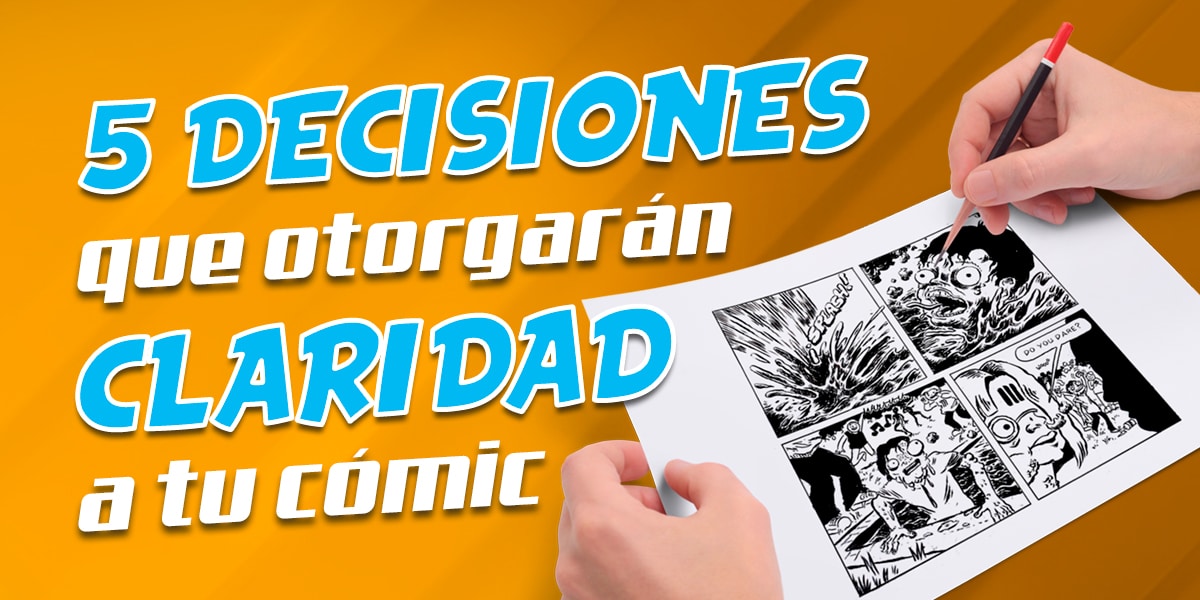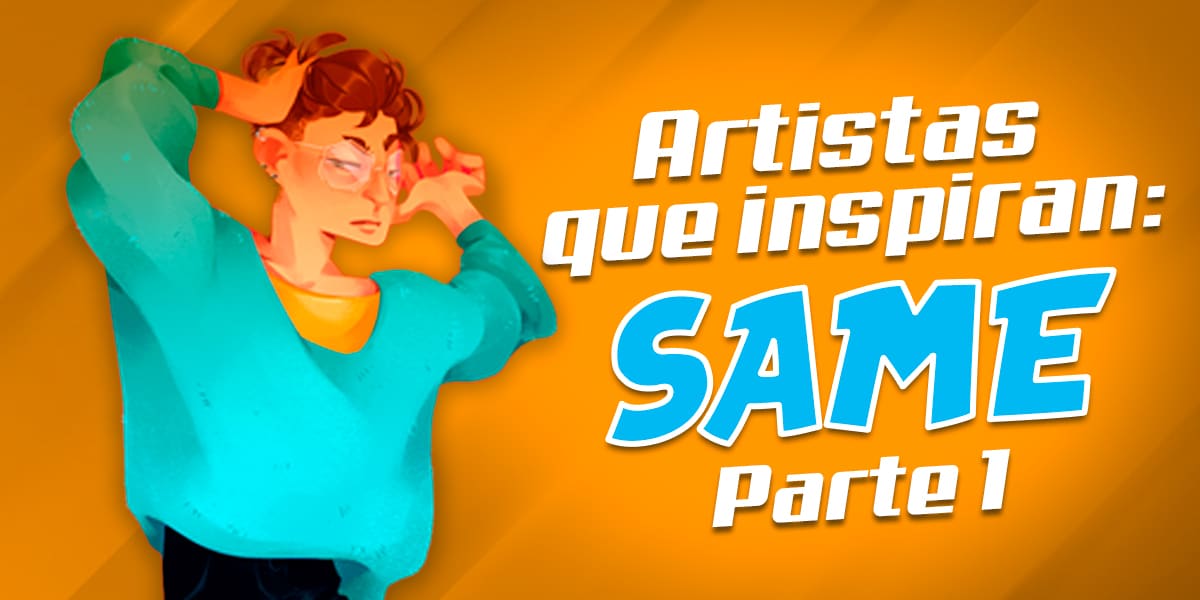5 decisiones cruciales para dar claridad a tu cómic
¿Alguna vez te has preguntado por qué algunos cómics te atrapan desde la primera página, mientras que otros te dejan confundido y sin ganas de seguir leyendo? La respuesta está en la claridad narrativa, un arte que los grandes creadores de cómics dominan a la perfección. En este artículo, te revelaremos los secretos detrás de las 5 decisiones fundamentales que pueden transformar tu cómic de bueno a extraordinario.
Prepárate para sumergirte en el fascinante mundo de la narrativa visual, donde cada trazo, cada palabra y cada encuadre cuentan una historia. Descubrirás cómo los maestros del cómic logran que sus páginas fluyan sin esfuerzo, cautivando a los lectores y transportándolos a universos increíbles. ¿Estás listo para llevar tus habilidades de narración gráfica al siguiente nivel? ¡Sigue leyendo y desbloquea el potencial oculto de tus creaciones!
La magia detrás de las decisiones correctas en el cómic
Leer cómics es una de las experiencias más cautivadoras que existen. Nos sumergimos en mundos fantásticos, vivimos aventuras emocionantes y conectamos con personajes inolvidables. Pero detrás de esa magia que nos atrapa por horas, hay un trabajo meticuloso y apasionado de artistas que dominan el arte de contar historias visualmente.
Los creadores de cómics tienen un superpoder: la capacidad de transmitir ideas, emociones y narrativas complejas a través de una combinación perfecta de imágenes y palabras. Su misión es que nosotros, los lectores, nos dejemos llevar por la historia sin tropiezos, sin confusiones, sin nada que interrumpa el flujo de nuestra imaginación.
Para lograr esta hazaña, los artistas de cómics tienen muy claro que cuando dibujan sus historias, necesitan que los lectores entiendan lo que tienen para contarles. No se trata solo de hacer dibujos bonitos o escribir diálogos ingeniosos; se trata de crear una experiencia inmersiva y coherente que mantenga al lector enganchado de principio a fin.
Hoy vamos a adentrarnos en los secretos del oficio, inspirados en los valiosos consejos del legendario Scott McCloud, un verdadero gurú en el arte de hacer cómics. Te mostraremos cómo puedes aplicar sus enseñanzas para persuadir a tu público y contar tu historia de la forma más clara y efectiva posible. ¿Listo para elevar tu arte a nuevas alturas? ¡Presta atención, porque cada consejo es oro puro para tu desarrollo como creador de cómics!
Las 5 elecciones maestras que definirán la claridad de tu cómic
En el mundo del cómic, la claridad es reina. No importa cuán brillante sea tu idea o cuán hermosos sean tus dibujos; si tu historia no se entiende, habrás perdido a tu lector. Por eso, dominar estas cinco decisiones fundamentales es crucial para crear cómics que no solo se vean bien, sino que también se lean con fluidez y se entiendan a la perfección.
1. La elección del momento: El arte de capturar el instante perfecto
Imagina que tu cómic es como una película, pero en lugar de 24 fotogramas por segundo, tienes que contar toda una historia con un puñado de imágenes estáticas. Aquí es donde entra en juego la elección del momento, una habilidad que separa a los buenos creadores de cómics de los verdaderos maestros.
La clave está en seleccionar los instantes que representen de la forma más directa y eficaz el argumento de tu historia. Cada viñeta debe ser una ventana a un momento crucial que haga avanzar la trama o revele algo importante sobre los personajes o el mundo que has creado.
Veamos un ejemplo práctico: imagina una secuencia donde un joven se lanza a una piscina llena de ácido, sale deformado, es ovacionado por una multitud en una fiesta, y finalmente, dos chicas consideran seguir su ejemplo. Parece una locura, ¿verdad? Pero observa cómo podemos capturar toda esta acción en solo cuatro viñetas estratégicamente elegidas:
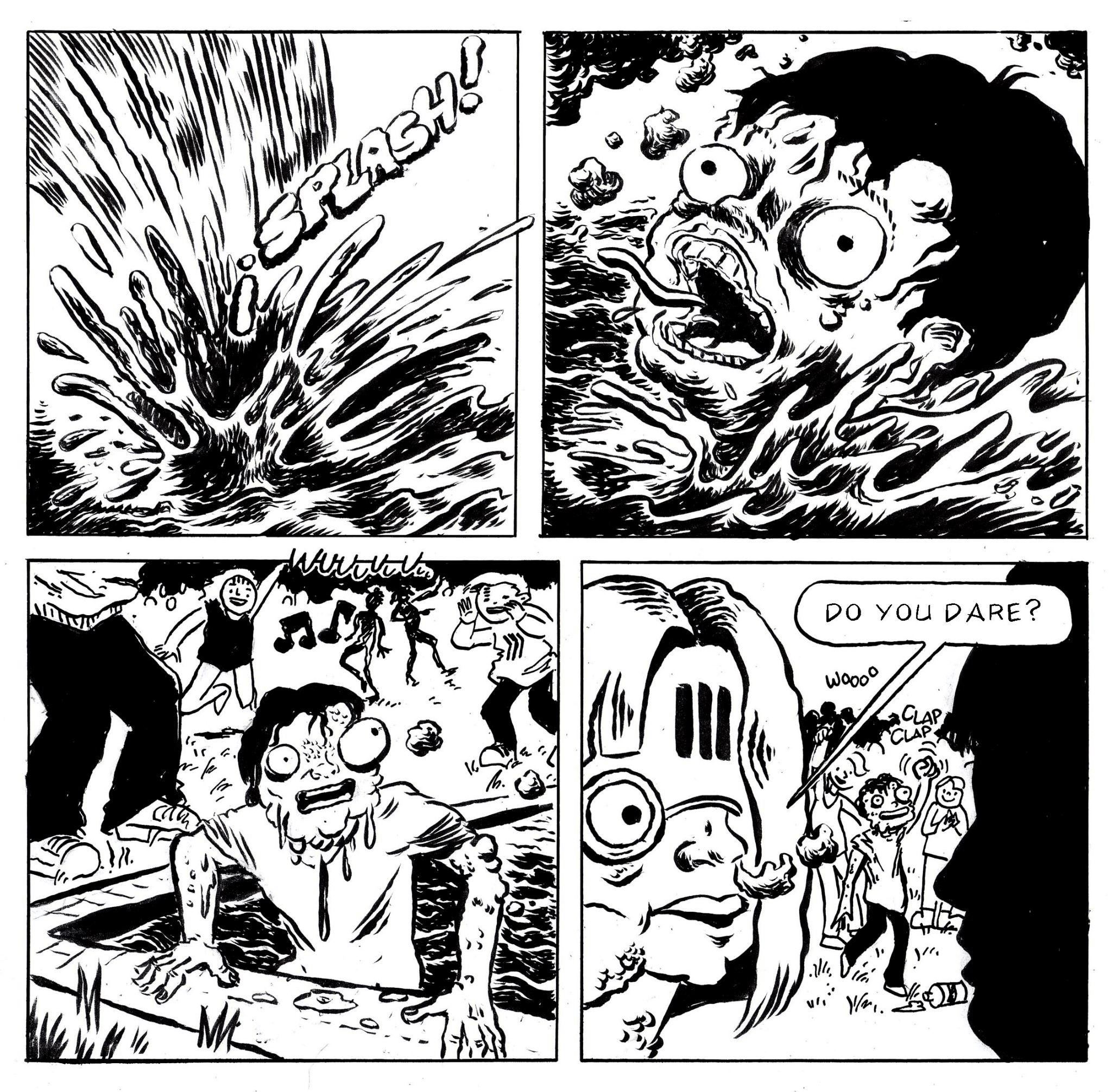
En la primera viñeta, mostramos el impacto inicial con la superficie líquida. La segunda nos revela al joven transformado. La tercera amplía el contexto, mostrándonos la piscina, la fiesta y la ovación. Y la última captura la reacción y la tentación de las dos chicas, con el chico deformado de fondo.
Esta secuencia demuestra cómo, con una cuidadosa selección de momentos, podemos contar una historia compleja en un espacio limitado. Cada viñeta es esencial y aporta información nueva y crucial para la comprensión de la narrativa.
Recuerda, la elección del momento es parte fundamental de la planificación de tu cómic. Cada viñeta debe ser como una pieza irremplazable de un rompecabezas, contribuyendo de manera única a la historia. Si puedes quitar una viñeta sin que se altere significativamente el sentido de la secuencia, probablemente esa viñeta sea prescindible.
Para dominar esta habilidad, es crucial entender y aplicar las diferentes transiciones entre viñetas. Por ejemplo, las transiciones de escena a escena te permiten comprimir la historia y mostrar momentos muy distantes en tiempo y espacio. Por otro lado, las transiciones de momento a momento pueden ralentizar la acción y aumentar el suspenso, mostrando cambios sutiles pero significativos.
¿Quieres llevar tu narrativa visual al siguiente nivel? Descubre aquí cómo perfeccionar el arte de elegir los momentos perfectos para tu cómic. Aprenderás técnicas avanzadas para capturar la esencia de cada escena y mantener a tus lectores pegados a la página.
2. La elección del encuadre: Tu ventana al mundo del cómic
Una vez que has seleccionado los momentos clave de tu historia, el siguiente paso es decidir cómo los vas a mostrar. La elección del encuadre es como elegir a través de qué ventana tus lectores verán el mundo que has creado. Es una herramienta poderosa que puede cambiar completamente la percepción y el impacto de una escena.
Piensa en el encuadre como el lente de una cámara. Puedes acercarte para mostrar detalles íntimos y emociones sutiles, o alejarte para establecer el contexto y la atmósfera general. Cada decisión que tomes influirá en cómo el lector interpreta y se conecta con la escena.
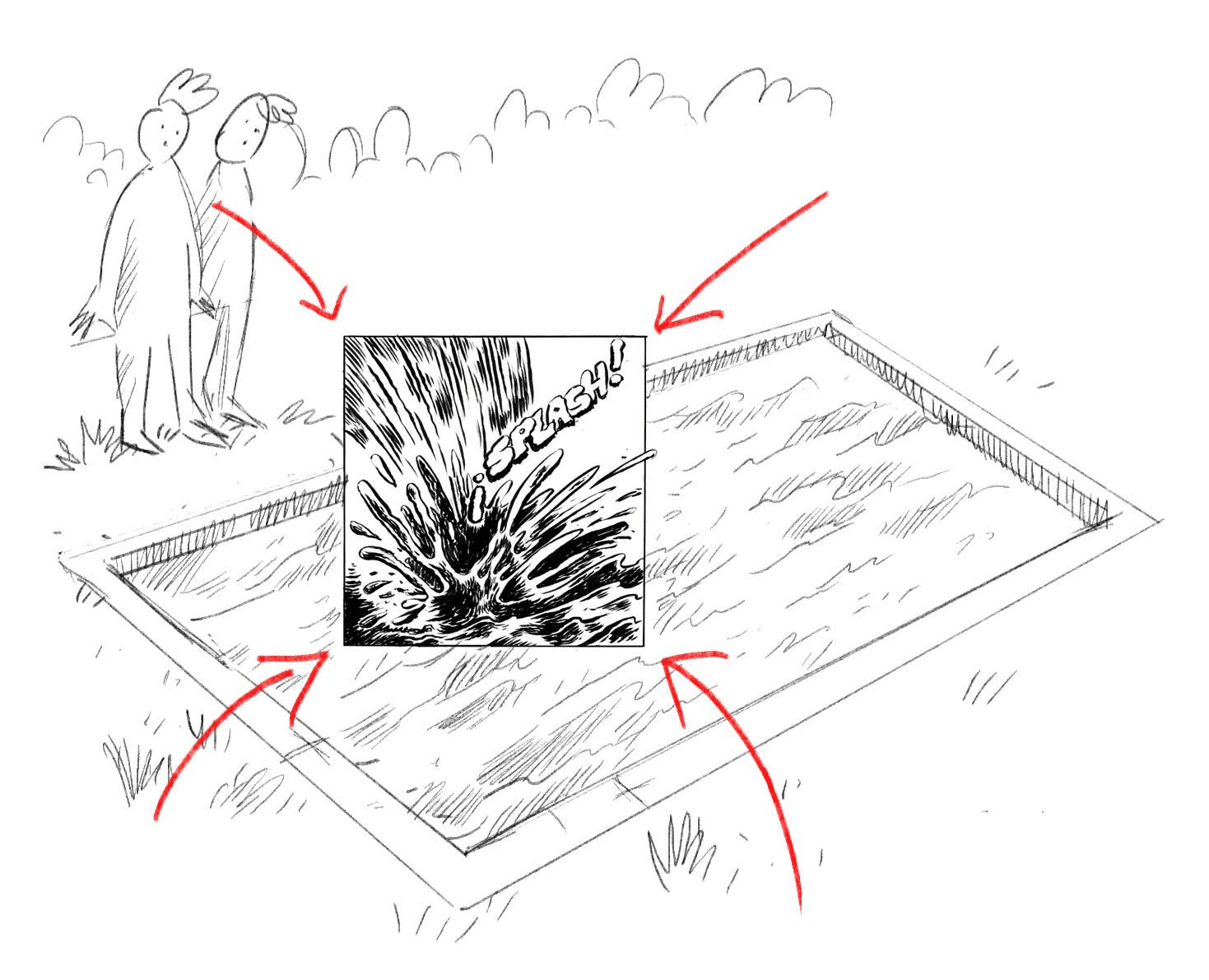
En nuestra secuencia de la piscina de ácido, por ejemplo, elegimos un primer plano para la salpicadura inicial. Este encuadre cercano enfatiza el impacto y crea tensión inmediata. No necesitamos mostrar todo el contexto en ese momento; el foco está en la acción crucial.
Los ángulos también juegan un papel fundamental en la narración visual. Un ángulo bajo puede hacer que un personaje parezca imponente o amenazador, mientras que un ángulo alto puede hacerlo parecer vulnerable o insignificante. Jugar con estas perspectivas te permite comunicar relaciones de poder y emociones sin necesidad de palabras.
La distancia es otro factor a considerar. Los planos generales son excelentes para establecer el escenario y dar al lector una sensación de espacio, mientras que los primeros planos pueden capturar emociones intensas y detalles cruciales. La clave está en variar estos elementos para mantener el interés visual sin distraer de la narrativa principal.
Recuerda también la importancia de la composición dentro de cada viñeta. La forma en que organizas los elementos visuales puede guiar la mirada del lector, enfatizar ciertos aspectos de la escena y crear un flujo visual que complemente la narrativa.
Dominar la elección del encuadre requiere práctica y experimentación. No tengas miedo de probar diferentes ángulos y distancias para la misma escena. A veces, un pequeño cambio en el encuadre puede transformar completamente el impacto de una viñeta.
¿Quieres explorar más sobre cómo el encuadre puede elevar tu narrativa visual? Haz clic aquí para descubrir técnicas avanzadas de encuadre en cómics. Aprenderás a utilizar perspectivas innovadoras que harán que tus lectores vean tu historia desde ángulos que nunca imaginaron.
3. La elección de la imagen: Dando vida a tu visión
Una vez que has planificado tus momentos y decidido cómo encuadrarlos, llega el momento de dar vida a tu visión a través del dibujo. La elección de la imagen es donde tu estilo personal y habilidades técnicas realmente brillan, pero también es donde puedes hacer o deshacer la claridad de tu narrativa.
El objetivo aquí es ser específico en tu dibujo, incorporando detalles de la vida real que anclen tu historia en un mundo creíble, por más fantástico que sea. Sin embargo, ser específico no significa simplemente hacer dibujos “bonitos”. Se trata de tomar decisiones conscientes sobre cada elemento visual para comunicar de manera efectiva.
Considera cuidadosamente las posturas y expresiones de tus personajes. Cada gesto, cada mirada, debe transmitir emociones y pensamientos que complementen o incluso contradigan el diálogo. La expresión corporal es un lenguaje en sí mismo, y dominarla puede añadir capas de profundidad a tu narración.
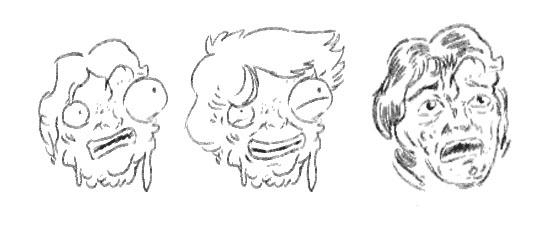
El nivel de abstracción o realismo en tus dibujos también es una decisión crucial. Un estilo más realista puede ayudar a crear un mundo más inmersivo y detallado, mientras que un enfoque más abstracto o caricaturesco puede permitirte exagerar emociones y situaciones para un mayor impacto.
En nuestra secuencia de la piscina de ácido, por ejemplo, optamos por un estilo que se inclina hacia lo grotesco. Esta elección estética refuerza el tono absurdo y perturbador de la escena. Un estilo más realista podría haber hecho que la secuencia fuera demasiado gráfica o perdiera su toque de humor negro.
Presta atención a los detalles que anclan tu historia en la realidad, incluso en situaciones fantásticas. En nuestro ejemplo, asegurarnos de que el personaje tuviera el pelo mojado después de salir de la piscina añade un toque de verosimilitud que hace que la escena sea más creíble dentro de su locura.
La coherencia en tu estilo es crucial para mantener la inmersión del lector. Desarrolla un “vocabulario visual” consistente para tu cómic, desde la forma en que dibujas ciertos objetos hasta cómo representas efectos como movimiento o sonido.
Recuerda que cada elección visual debe servir a tu historia. No te dejes llevar por el deseo de mostrar tu habilidad técnica si eso no contribuye a la narrativa. A veces, un dibujo más simple pero efectivo puede comunicar mejor que uno elaborado pero confuso.
¿Quieres llevar tus habilidades de dibujo al siguiente nivel y crear imágenes que realmente cuenten una historia? Ingresa aquí para perfeccionar el arte de la narración visual en cómics. Descubrirás técnicas avanzadas para crear personajes expresivos y mundos vívidos que cautiven a tus lectores.
4. La elección de la palabra: El poder del diálogo y la narración
En el mundo del cómic, las palabras y las imágenes deben trabajar en perfecta armonía. La elección de la palabra es un arte en sí mismo, tan crucial como el dibujo para crear una narrativa clara y cautivadora. Es el momento de decidir no solo qué decir, sino también cómo decirlo y, a veces, qué no decir en absoluto.
Las palabras en un cómic tienen un poder único: pueden comprimir una historia, resumir momentos en pocas viñetas y añadir capas de significado que las imágenes por sí solas no pueden transmitir. Sin embargo, el verdadero desafío está en integrar texto e imagen de manera tan fluida que el lector no note la transición entre leer y ver.
Considera cuidadosamente cuándo es necesario añadir texto a tus viñetas. A veces, una imagen vale más que mil palabras, y otras veces, unas pocas palabras bien elegidas pueden dar contexto crucial a una imagen aparentemente simple.
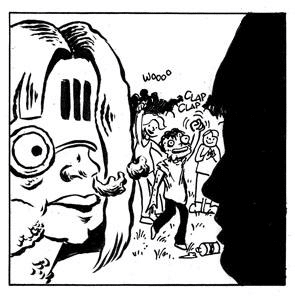
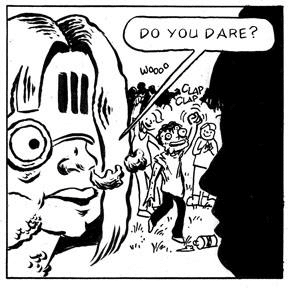
En nuestra secuencia de la piscina de ácido, por ejemplo, la viñeta final se beneficia enormemente de un globo de diálogo. Sin esas palabras, la intención de los personajes podría ser ambigua. El texto “¿Te animas?” añade contexto crucial y avanza la narrativa de una manera que la imagen sola no podría lograr.
Sin embargo, es igualmente importante saber cuándo dejar que las imágenes hablen por sí mismas. En la tercera viñeta de nuestra secuencia, donde vemos al personaje deformado saliendo de la piscina rodeado de gente, no es necesario añadir diálogo. La imagen comunica eficazmente la situación y la reacción de la multitud. Agregar texto aquí podría resultar redundante y distraer del impacto visual de la escena.
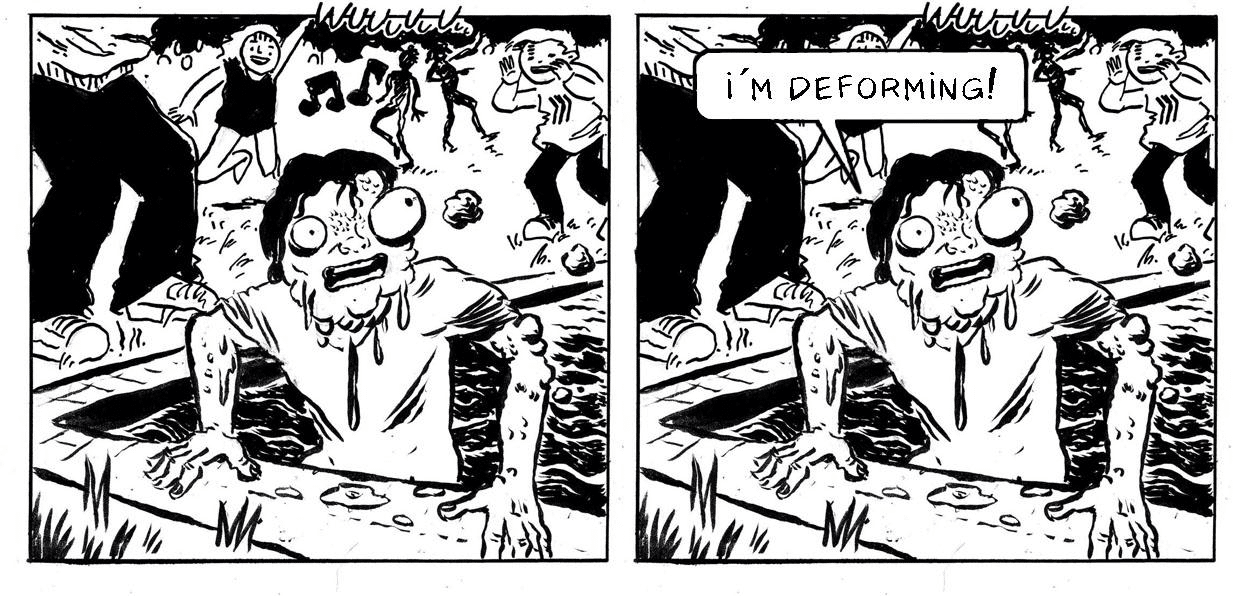
La elección de la palabra también implica decidir el estilo de tu narración y diálogo. ¿Usarás un narrador omnisciente? ¿Monólogos internos de los personajes? ¿Diálogos concisos o conversaciones extensas? Cada elección afectará el ritmo y el tono de tu cómic.
Recuerda que el texto en un cómic no se limita solo a diálogos y narración. Las onomatopeyas, los efectos de sonido y hasta el diseño tipográfico pueden añadir dimensiones adicionales a tu narrativa. Un “¡BOOM!” bien colocado puede hacer que el lector casi sienta la explosión, mientras que un susurro representado con letras pequeñas y temblorosas puede transmitir tensión y secretismo.
Al integrar texto e imagen, piensa en cómo pueden complementarse mutuamente. A veces, el contraste entre lo que se dice y lo que se muestra puede crear ironía o humor. Otras veces, las palabras pueden reforzar y amplificar el mensaje de la imagen.
¿Quieres mejorar tus habilidades para integrar texto e imagen de manera efectiva en tus cómics? Explora más aquí sobre el arte de combinar palabras y dibujos en la narración gráfica. Descubrirás técnicas avanzadas para crear diálogos convincentes y narraciones que complementen perfectamente tus ilustraciones.
5. La elección del flujo: Guiando al lector a través de tu historia
La última, pero no menos importante, de las decisiones cruciales es la elección del flujo. Esta es la habilidad de guiar al lector suavemente a través de tu cómic, desde la primera viñeta hasta la última, creando una experiencia de lectura fluida y satisfactoria.
En el mundo occidental, existe un contrato tácito entre el creador y el lector: las viñetas se leen de izquierda a derecha y de arriba abajo. Este patrón de lectura se aplica también dentro de cada viñeta para los diferentes elementos de texto. Sin embargo, el verdadero arte está en cómo utilizas y, a veces, desafías estas convenciones para crear un flujo narrativo dinámico y atrapante.
El diseño de tu página juega un papel crucial en el flujo. La disposición de las viñetas, su tamaño y forma, pueden guiar la mirada del lector de manera intuitiva o crear pausas dramáticas en momentos clave. Un diseño de página bien pensado no solo sirve a tu historia, sino que se convierte en parte integral de la narración.
Dentro de cada viñeta, la composición es tu herramienta para dirigir la atención del lector. Utiliza líneas de acción, el contraste entre luz y sombra, y la colocación estratégica de elementos para crear un recorrido visual que complemente el orden de lectura de los diálogos y narraciones.
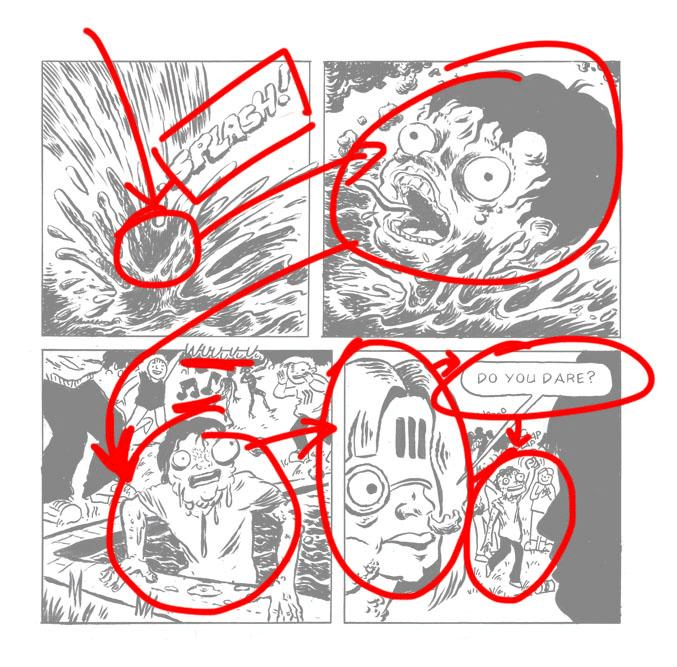
En nuestra secuencia de ejemplo, podemos ver cómo la ubicación de los elementos contribuye a una narrativa fluida. En la cuarta viñeta, por ejemplo, el ojo del lector naturalmente sigue un camino de izquierda a derecha y de arriba abajo: primero ve a la chica, luego lee “¿Te animas?”, y finalmente observa al chico deformado y la silueta de quien escucha. Esta disposición permite que el cerebro asocie rápidamente los elementos y comprenda la situación en el orden correcto.
Es importante evitar el exceso de complejidad en tus encuadres y ángulos. Si bien es tentador mostrar tu habilidad técnica con perspectivas elaboradas, recuerda que tu objetivo principal es contar una historia. Un encuadre demasiado complejo puede confundir al lector y sacarlo de la narrativa.
A medida que ganes experiencia, desarrollarás la habilidad de predecir a qué prestarán atención los lectores en cada viñeta. Usa este conocimiento para tu beneficio, guiando sutilmente su atención hacia los elementos más importantes de tu historia.
Recuerda que el flujo no solo se trata de la disposición visual, sino también del ritmo narrativo. Alterna entre secuencias de acción rápida y momentos de calma reflexiva para crear un ritmo que mantenga al lector enganchado. Usa viñetas más pequeñas y numerosas para acelerar el ritmo, y viñetas más grandes o páginas completas para momentos de impacto o contemplación.
¿Quieres dominar el arte de crear un flujo narrativo irresistible en tus cómics? Haz clic aquí para explorar técnicas avanzadas de composición y diseño de página. Aprenderás a crear layouts que no solo se vean increíbles, sino que también guíen a tus lectores a través de tu historia de manera fluida y emocionante.
Conclusión: El camino hacia la maestría en la claridad del cómic
Dominar estas cinco decisiones cruciales —momento, encuadre, imagen, palabra y flujo— es el camino hacia la creación de cómics que no solo se ven bien, sino que también se leen con fluidez y dejan una impresión duradera en los lectores. Cada elección que tomes en estas áreas contribuirá a la claridad y el impacto de tu narrativa visual.
Recuerda, no es necesario que abordes estas decisiones en un orden estricto. A menudo, trabajarás en varias de ellas simultáneamente, ajustando y refinando cada aspecto a medida que tu historia cobra vida. La clave está en ser consciente de cómo cada elección afecta a las demás y a la experiencia general del lector.
La práctica constante y la experimentación son tus mejores aliados en este viaje. No tengas miedo de probar nuevas técnicas, desafiar las convenciones cuando sea apropiado, y sobre todo, de aprender de cada página que crees. Con el tiempo, desarrollarás un instinto para estas decisiones que te permitirá contar historias cada vez más poderosas y cautivadoras.
Recuerda siempre que el objetivo final es comunicar tu historia de la manera más clara y efectiva posible. Cada trazo, cada palabra, cada composición debe estar al servicio de tu narrativa. Cuando logres una armonía perfecta entre todos estos elementos, habrás creado un cómic que no solo se lee, sino que se vive.
¿Estás listo para llevar tus habilidades de narración gráfica al siguiente nivel? Descubre aquí recursos avanzados y técnicas profesionales para perfeccionar tu arte. Con dedicación y las herramientas adecuadas, podrás crear cómics que no solo cuenten historias, sino que transporten a tus lectores a mundos extraordinarios que nunca olvidarán.
Bibliografía: Scott McCloud, Making Comics: Storytelling Secrets of Comics, Manga and Graphic Novels. William Morrow Paperbacks, 2006.

